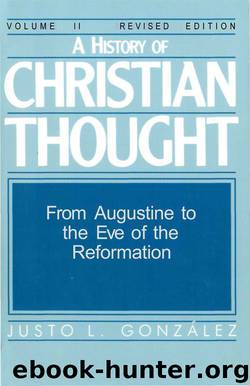A History of Christian Thought Volume 2: From Augustine to the Eve of the Reformation: 002 by Gonzalez Justo L

Author:Gonzalez, Justo L [Gonzalez, Justo L]
Language: eng
Format: epub
Tags: Book
Publisher: Abingdon Press
Published: 2009-06-01T00:00:00+00:00
* * *
1 M. de Gandillac and E. Jeauneau, Entretiens sur la Renaissance deu 12' siecle (Paris: Mouton, 1968); M. D. Chcnu, Salure, Man and Society in the 12th Century: Essays on .Wu1 Theological Perspectives in the Latin West (Chicago: University Press, 1968); R. L. Benson et al., eds., Renaissance and Renewal in the Twelfth Century (Oxford: Clarendon, 1982).
2 The best study of that method is J. Mclntyre, St. Anselm and His Critics: A Reinttrpretation of the Cur Devi homo (Edinburgh: Oliver & Boyd, 1954). See also: W. Betzenddrfer, "Glauben und Wissen bei Anselm von Canterbury," ZschrKgesch, 48 (1929), 354-70; A. M. Jacquin, "Les 'rationes necessariae' de Saint Anselme," in Melanges Mandonnet, II (Paris: J. Vrin, 1930), 67-78; B. Geyer, "Zur Deutung von Anselms Cur Deus homo," ThGl, 34 (1942), 203-10; G. B. Phelan, The Wisdom of Saint Anselm (Latrobe, Pa.: Archabbey Press, 1960); R. Campbell, "Anselm's Theological Method," SJT, 32 (1979), 541-62. For general information and bibliography on Anselm, see also the articles on the periodical publication AnaUcta Anselmiana, published in Frankfurt since 1969.
3 Cur Deus homo 1. 1.
4 Proslog. 1 (trans. M. J. Charlesworth, St. Amelm's Proslogion, Oxford: Clarendon Press, 1965, p. 115).
5Monolog. prologue. Cf. P. Gilbert, Dire I'ineffabU: Lecture du 'Monologion' de S. Anselmt (Paris: Lethielleux, 1984).
6 The argument to prove this is that several such beings could not be distinguished in any way, for none of them would lack something that the others have. As that which is undistinguishable is one, being itself can only be one.
7 Monolog. 1-14.
8 Proslog. 2 (trans. Charlesworth, p. 117).
9 Ibid., 3 (trans. Charlesworth, p. 119).
10 Ibid., 4 (trans. Charlesworth, p. 121).
11 Apart from its importance for the history of philosophy, due to the fact that it has been discussed, reinterpreted, and evaluated by men such as Thomas Aquinas, Descartes, Kant, and Hegel, this argument has been the subject of a vast number of recent studies. Among these, see: K. Barth, Fides quarins mtelleclum: Anselmus Beweis der Existeni Gottes im Zusammenhang semes theologischen Programms (Munich: C. Kaiser, 1931); A. Antweiler, "Anselmus von Canterbury, Monologion und Proslogion," Sch, 8 (1933); 551-60; F. S. Schmitt, "Der ontologische Gottesbeweis Anselms," ThR, 32 (1933), 217-23; E. Gilson, "Sens et nature de l'argument de saint Anselme," AHDLMA, 9 (1934), 5-51; A. Kolping, Anselms Proslogion-Beweis der Existenz Gottes im Zusammenhang seines spekulativen Programms fides quarens inullectum (Bonn: P. Hanstein, 1939); F. Spedalieri, "De intrinseca argumenti S. Anselmi vi et Natura," Greg, 39 (1948), 204-12. There is a good summary of recent discussion by A. C. McGill, "Recent Discussions of Anselm's Argument," in The Many-faced Argument (New York: Macmillan, 1967). G. R. Evans, Anselm and Talking about God (Oxford: Clarendon Press, 1978). After this lengthy note I should add, however, that it is mostly philosophers and theologians who still debate Anselm's argument, for there is general agreement among historians as to the manner in which Anselm himself understood it.
I2Pro insip. 7.
13Ibid., 4.
14Ibid., 6.
15 Monolog. 16-17; Proslog. 12.
16 Monolog. 20.
17Ibid., 21.
18 Ibid., 22-24; Proslog. 19.
19 R. Perino, La dottrina trinitaria di S.
Download
This site does not store any files on its server. We only index and link to content provided by other sites. Please contact the content providers to delete copyright contents if any and email us, we'll remove relevant links or contents immediately.
The Gnostic Gospels by Pagels Elaine(2473)
Jesus by Paul Johnson(2313)
Devil, The by Almond Philip C(2284)
The Nativity by Geza Vermes(2181)
The Psychedelic Gospels: The Secret History of Hallucinogens in Christianity by Jerry B. Brown(2122)
Forensics by Val McDermid(2049)
Going Clear: Scientology, Hollywood, and the Prison of Belief by Lawrence Wright(1940)
Going Clear by Lawrence Wright(1927)
Barking to the Choir by Gregory Boyle(1786)
Old Testament History by John H. Sailhamer(1770)
Augustine: Conversions to Confessions by Robin Lane Fox(1737)
The Early Centuries - Byzantium 01 by John Julius Norwich(1702)
A History of the Franks by Gregory of Tours(1688)
A Prophet with Honor by William C. Martin(1685)
Dark Mysteries of the Vatican by H. Paul Jeffers(1678)
The Bible Doesn't Say That by Dr. Joel M. Hoffman(1652)
by Christianity & Islam(1596)
The First Crusade by Thomas Asbridge(1576)
The Amish by Steven M. Nolt(1534)
